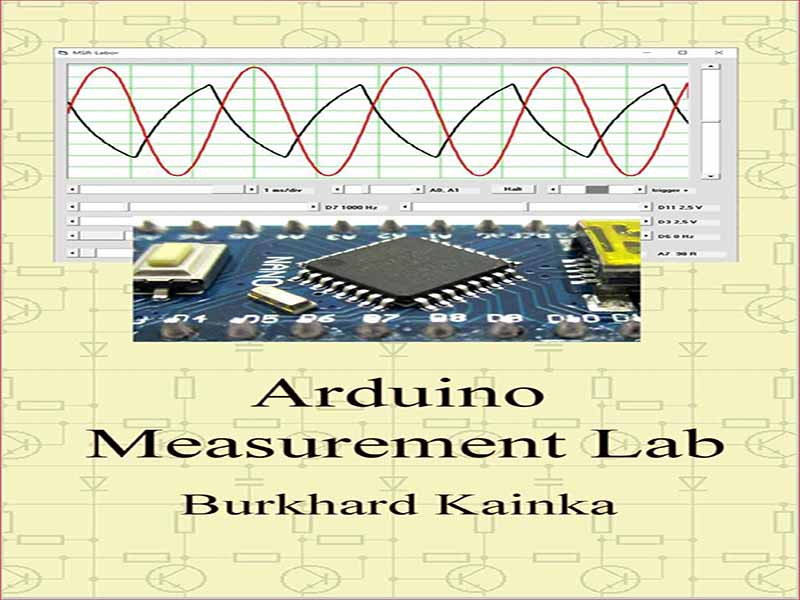- عنوان مجله: Arduino Measurement Lab
- نویسنده: Kainka,-Burkhard
- حوزه: بورد الکترونیکی
- سال انتشار: 2022
- تعداد صفحه: 171
- زبان اصلی: انگلیسی
- نوع فایل: pdf
- حجم فایل: 12.4 مگابایت
اولین ملاحظات برای یک سیستم اندازه گیری جهانی در جهت یک اسیلوسکوپ کامپیوتر دیجیتال همراه با یک ژنراتور سیگنال بود. در اولین آزمایش یک برد Bluepill را با یک کنترلر STM32 آزمایش کردم. این کنترلر Cortex M3 با نرخ کلاک تا 72 مگاهرتز دارای مبدل AD بسیار سریع و رابط USB یکپارچه است. اساساً همه کارها را می توان توسط یک کنترلر انجام داد. داده های آنالوگ ذخیره می شوند در حالی که در همان زمان مقادیر جدول DDS به خروجی های سریع PWM ارسال می شود تا سیگنال های سینوسی یا سایر شکل موج ها تولید شود. آزمایشها بسیار زیاد پیش رفتند، اما در نهایت برخی عوامل تداخلی آشکار شدند. برای وظایف انتخاب شده مهم است که نمونه اندازه گیری و خروجی ها در یک چارچوب زمانی سریع و بسیار دقیق اجرا شوند. نرخ های نمونه برداری تا 100 کیلوهرتز در فرکانس PWM 125 کیلوهرتز با دو خروجی و دو کانال ورودی هر کدام به دست آمد. اما یک لرزش خفیف دائمی در بازه زمانی وجود داشت که علت آن را باید در تقاضاهای همزمان رابط USB جستجو کرد. اگر اندازه گیری واقعی و خروجی سیگنال در یک وقفه تایمر با فرکانس 100 کیلوهرتز اجرا شود، هیچ وقفه دیگری نباید مجاز باشد. به محض اینکه یک وقفه تایمر دوم یا در این مورد یک وقفه USB اضافه شود، شبکه زمانی کاملاً یکنواخت به پایان می رسد. علاوه بر این، مشکلات تحویل وجود داشت. بحران عمومی نیمه هادی در سال 2021 به این معنی بود که بورد Bluepill نیز به سختی به دست می آمد. آن هم به این شکل تمام شد. خداحافظ بلوپیل!
The first considerations for a universal measuring system went in the direction of a digital PC oscilloscope combined with a signal generator. The In the first experiment I tested a Bluepill board with a STM32 controller. This Cortex M3 controller with a clock rate up to 72 MHz has a very fast AD converter and an integrated USB interface. Basically all tasks can be done by the same controller. Analog data is stored while at the same time values of a DDS table are sent to the fast PWM outputs to generate sine signals or other waveforms. The experiments went quite far, but in the end some interfering factors came to light. For the chosen tasks it is important that the measuring sample and the outputs run in a fast and very accurate time frame. Sampling rates up to 100 kHz at a PWM frequency of 125 kHz with two output and two input channels each were achieved. But there was a permanent slight flutter in the time frame, the cause of which was to be found in the simultaneous demands of the USB interface. If the actual measurement and signal output is executed in a timer interrupt with 100 kHz, no other interrupt should be allowed. As soon as a second timer interrupt or as in this case a USB interrupt is added, the absolutely uniform time grid is over. In addition, there were delivery problems. The general semiconductor crisis in 2021 meant that the Bluepill board was also hard to come by. That also ended this way. Bye bye Bluepill!
این کتاب را میتوانید از لینک زیر بصورت رایگان دانلود کنید:
Download: Arduino Measurement Lab



































نظرات کاربران